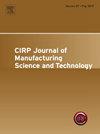Hybrid wire arc directed energy deposition and machining approach for realizing density-based functionally graded materials with enhanced strength-to-weight ratios
IF 5.4
2区 工程技术
Q2 ENGINEERING, MANUFACTURING
CIRP Journal of Manufacturing Science and Technology
Pub Date : 2025-06-17
DOI:10.1016/j.cirpj.2025.06.005
引用次数: 0
Abstract
Wire Arc Directed Energy Deposition (WADED), a high-deposition-rate Additive Manufacturing (AM) technique, enables the rapid fabrication of near-net-shape metallic components. However, achieving Functionally Graded Materials (FGMs) with density variations within the same material remains challenging. This study introduces a novel Hybrid WADED (H-WADED) process to fabricate mono-material FGMs with engineered density gradients tailored for applications in aerospace, nuclear energy, and electromagnetism. In this method, each layer is deposited using WADED, followed by face milling and robotic drilling to introduce controlled holes. The diameter and spacing of the holes are designed to achieve the desired density gradient, enabling up to a 10 % reduction in mass. Experimental results showed 2 mm diameter holes as optimal, minimizing material flow and distortion while improving the strength-to-weight ratio. This innovation also enhances thermal dissipation capabilities, making the components suitable for high-stress environments. Performance evaluation of the fabricated FGMs revealed a 26.2 % reduction in thermal conductivity and significant mitigation of residual stresses due to stress redistribution around the holes. Under compressive loading, the samples exhibited a maximum load capacity of 200 kN. Although tensile strength was reduced by 19.6 % compared to solid samples, elongation remained unaffected, highlighting the structural integrity of the components. This work demonstrates an effective method to fabricate density-based FGMs, providing a practical pathway for developing advanced, lightweight, and thermally efficient components for critical industrial applications.
复合电弧定向能沉积和加工方法,实现基于密度的功能梯度材料的增强强度与重量比
电弧定向能沉积(wded)是一种高沉积速率的增材制造(AM)技术,可以快速制造近净形状的金属部件。然而,在同一材料中实现密度变化的功能梯度材料(fgm)仍然具有挑战性。本研究介绍了一种新型的混合WADED (H-WADED)工艺,用于制造具有工程密度梯度的单材料fgm,适用于航空航天、核能和电磁领域。在这种方法中,每层都使用wded沉积,然后进行面铣和机器人钻孔以引入受控孔。孔的直径和间距的设计可以达到所需的密度梯度,从而使质量减少10%。实验结果表明,直径为2mm的孔最优,可最大限度地减少材料流动和变形,同时提高强度与重量比。这一创新还提高了散热能力,使组件适用于高应力环境。对制造的fgm的性能评估显示,由于孔周围的应力重新分布,热导率降低了26.2%,残余应力也得到了显著缓解。在压缩荷载作用下,试样的最大承载能力为200 kN。虽然与固体样品相比,拉伸强度降低了19.6%,但伸长率未受影响,突出了部件的结构完整性。这项工作展示了一种制造基于密度的fgm的有效方法,为开发用于关键工业应用的先进、轻量化和热效率高的组件提供了一条实用途径。
本文章由计算机程序翻译,如有差异,请以英文原文为准。
求助全文
约1分钟内获得全文
求助全文
来源期刊

CIRP Journal of Manufacturing Science and Technology
Engineering-Industrial and Manufacturing Engineering
CiteScore
9.10
自引率
6.20%
发文量
166
审稿时长
63 days
期刊介绍:
The CIRP Journal of Manufacturing Science and Technology (CIRP-JMST) publishes fundamental papers on manufacturing processes, production equipment and automation, product design, manufacturing systems and production organisations up to the level of the production networks, including all the related technical, human and economic factors. Preference is given to contributions describing research results whose feasibility has been demonstrated either in a laboratory or in the industrial praxis. Case studies and review papers on specific issues in manufacturing science and technology are equally encouraged.
 求助内容:
求助内容: 应助结果提醒方式:
应助结果提醒方式:


